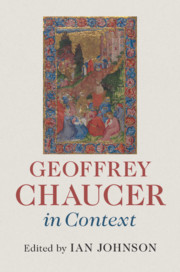Book contents
- Geoffrey Chaucer in Context
- Geoffrey Chaucer in Context
- Copyright page
- Contents
- Illustrations
- Contributors
- Abbreviations
- Introduction
- Part I Chaucer as Context
- Part II Books, Discourse and Traditions
- Part III Humans, the World and Beyond
- Chapter 19 Chaucer’s God
- Chapter 20 Holiness
- Chapter 21 Secularity
- Chapter 22 The Self
- Chapter 23 Women
- Chapter 24 Sex and Lust
- Chapter 25 Animals in Chaucer
- Part IV Culture, Learning and Disciplines
- Part V Political and Social Contexts
- Part VI Chaucer Traditions
- Further Reading
- Index
Chapter 22 - The Self
from Part III - Humans, the World and Beyond
Published online by Cambridge University Press: 24 June 2019
- Geoffrey Chaucer in Context
- Geoffrey Chaucer in Context
- Copyright page
- Contents
- Illustrations
- Contributors
- Abbreviations
- Introduction
- Part I Chaucer as Context
- Part II Books, Discourse and Traditions
- Part III Humans, the World and Beyond
- Chapter 19 Chaucer’s God
- Chapter 20 Holiness
- Chapter 21 Secularity
- Chapter 22 The Self
- Chapter 23 Women
- Chapter 24 Sex and Lust
- Chapter 25 Animals in Chaucer
- Part IV Culture, Learning and Disciplines
- Part V Political and Social Contexts
- Part VI Chaucer Traditions
- Further Reading
- Index
Summary
Rather than trawl through medieval philosophical texts for references to selfhood, I analyse a story Chaucer knew well: that of Narcissus and Echo. Narcissus’s fatal encounter with his own reflection suggests a number of points: i) that self-awareness is associated with sight (the word ‘introspection’ means ‘looking within’); ii) that beauty also is associated with sight; iii) that love makes one self-aware (Narcissus understands that his love-object is himself, not that that helps him any); iv) that sight can be ironically linked to moral blindness. Chaucer explores all these points, often with reference to mirrors, and to women in love or being loved. Medieval mirrors were usually small and convex, requiring the viewer to stand close to interpret the distorted images from multiple angles that they generated. Chaucer especially represents women experiencing how it feels to ‘be me’, making of his own poetry a mirror that reflects from oblique positions.
- Type
- Chapter
- Information
- Geoffrey Chaucer in Context , pp. 187 - 193Publisher: Cambridge University PressPrint publication year: 2019

